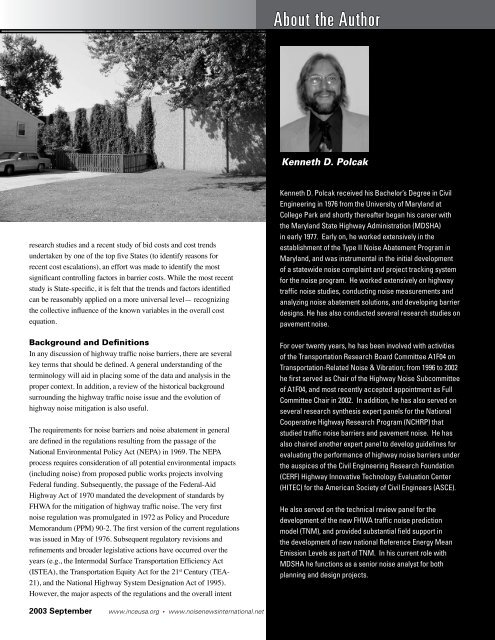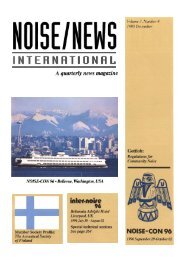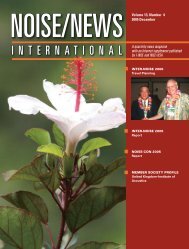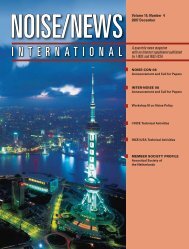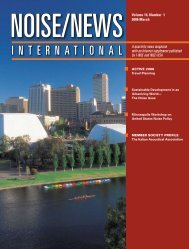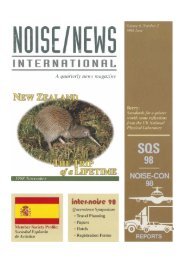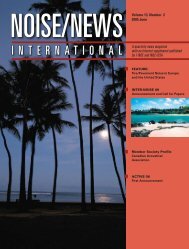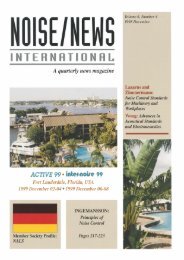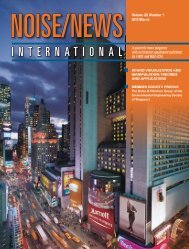Volume 11, Number 3, September, 2003 - Noise News International
Volume 11, Number 3, September, 2003 - Noise News International
Volume 11, Number 3, September, 2003 - Noise News International
You also want an ePaper? Increase the reach of your titles
YUMPU automatically turns print PDFs into web optimized ePapers that Google loves.
About the Author<br />
Kenneth D. Polcak<br />
research studies and a recent study of bid costs and cost trends<br />
undertaken by one of the top five States (to identify reasons for<br />
recent cost escalations), an effort was made to identify the most<br />
significant controlling factors in barrier costs. While the most recent<br />
study is State-specific, it is felt that the trends and factors identified<br />
can be reasonably applied on a more universal level— recognizing<br />
the collective influence of the known variables in the overall cost<br />
equation.<br />
Background and Definitions<br />
In any discussion of highway traffic noise barriers, there are several<br />
key terms that should be defined. A general understanding of the<br />
terminology will aid in placing some of the data and analysis in the<br />
proper context. In addition, a review of the historical background<br />
surrounding the highway traffic noise issue and the evolution of<br />
highway noise mitigation is also useful.<br />
The requirements for noise barriers and noise abatement in general<br />
are defined in the regulations resulting from the passage of the<br />
National Environmental Policy Act (NEPA) in 1969. The NEPA<br />
process requires consideration of all potential environmental impacts<br />
(including noise) from proposed public works projects involving<br />
Federal funding. Subsequently, the passage of the Federal-Aid<br />
Highway Act of 1970 mandated the development of standards by<br />
FHWA for the mitigation of highway traffic noise. The very first<br />
noise regulation was promulgated in 1972 as Policy and Procedure<br />
Memorandum (PPM) 90-2. The first version of the current regulations<br />
was issued in May of 1976. Subsequent regulatory revisions and<br />
refinements and broader legislative actions have occurred over the<br />
years (e.g., the Intermodal Surface Transportation Efficiency Act<br />
(ISTEA), the Transportation Equity Act for the 21 st Century (TEA-<br />
21), and the National Highway System Designation Act of 1995).<br />
However, the major aspects of the regulations and the overall intent<br />
Kenneth D. Polcak received his Bachelor’s Degree in Civil<br />
Engineering in 1976 from the University of Maryland at<br />
College Park and shortly thereafter began his career with<br />
the Maryland State Highway Administration (MDSHA)<br />
in early 1977. Early on, he worked extensively in the<br />
establishment of the Type II <strong>Noise</strong> Abatement Program in<br />
Maryland, and was instrumental in the initial development<br />
of a statewide noise complaint and project tracking system<br />
for the noise program. He worked extensively on highway<br />
traffic noise studies, conducting noise measurements and<br />
analyzing noise abatement solutions, and developing barrier<br />
designs. He has also conducted several research studies on<br />
pavement noise.<br />
For over twenty years, he has been involved with activities<br />
of the Transportation Research Board Committee A1F04 on<br />
Transportation-Related <strong>Noise</strong> & Vibration; from 1996 to 2002<br />
he first served as Chair of the Highway <strong>Noise</strong> Subcommittee<br />
of A1F04, and most recently accepted appointment as Full<br />
Committee Chair in 2002. In addition, he has also served on<br />
several research synthesis expert panels for the National<br />
Cooperative Highway Research Program (NCHRP) that<br />
studied traffic noise barriers and pavement noise. He has<br />
also chaired another expert panel to develop guidelines for<br />
evaluating the performance of highway noise barriers under<br />
the auspices of the Civil Engineering Research Foundation<br />
(CERF) Highway Innovative Technology Evaluation Center<br />
(HITEC) for the American Society of Civil Engineers (ASCE).<br />
He also served on the technical review panel for the<br />
development of the new FHWA traffic noise prediction<br />
model (TNM), and provided substantial field support in<br />
the development of new national Reference Energy Mean<br />
Emission Levels as part of TNM. In his current role with<br />
MDSHA he functions as a senior noise analyst for both<br />
planning and design projects.<br />
<strong>2003</strong> <strong>September</strong> www.inceusa.org • www.noisenewsinternational.net • www.i-ince.org<br />
97


